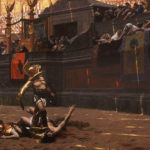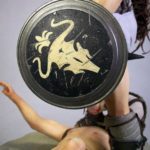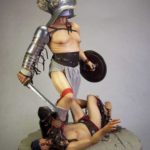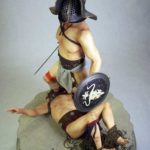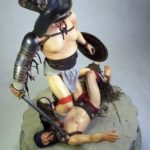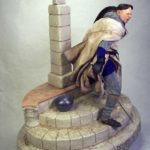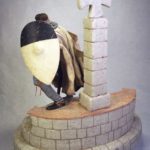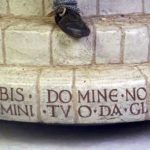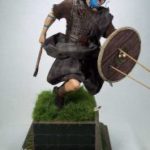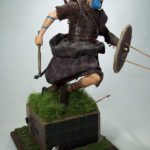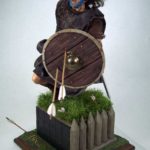“Jugula!” – Murmillo Vs. Retiarius
The Murmillo (also sometimes spelled mirmillo or myrmillo, pl. murmillones) was a type of gladiator during the Roman Imperial age. The murmillo-class gladiator was adopted in the early Imperial period to replace the earlier Gallus, named after the warriors of Gaul.
Wore a helmet with a stylized fish on the crest (the Mormylos or Sea fish), as well as an arm guard (Manica). They carried a gladius and an oblong shield in the Gallic style. They were paired with Hoplomachi or Thraces.
The Retiarius (plural retiarii; literally, “net-man” or “net-fighter” in Latin) was a gladiator who fought with equipment styled on that of a fisherman: a weighted net (Rete, hence the name), a three-pointed trident (Fuscina or tridens), and a dagger (Pugio). The Retiarius was lightly armoured, wearing an arm guard (Manica) and a shoulder guard (Galerus). Typically, his clothing consisted only of a loincloth (Subligaculum) held in place by a wide belt, or of a short tunic with light padding. He wore no head protection or footwear.
Knight Templar, 12th Century
The Poor Fellow-Soldiers of Christ and of the Temple of Solomon (Latin: Pauperes commilitones Christi Templique Salomonici), commonly known as the Knights Templar, the Order of the Temple (French: Ordre du Temple or Templiers) or simply as Templars, were among the most wealthy and powerful of the Western Christian military orders and were among the most prominent actors of the Christian finance. The organization existed for nearly two centuries during the Middle Ages.
Officially endorsed by the Catholic Church around 1129, the Order became a favoured charity throughout Christendom and grew rapidly in membership and power. Templar knights, in their distinctive white mantles with a red cross, were among the most skilled fighting units of the Crusades. Non-combatant members of the Order managed a large economic infrastructure throughout Christendom, innovating financial techniques that were an early form of banking, and building fortifications across Europe and the Holy Land.
The Templars’ existence was tied closely to the Crusades; when the Holy Land was lost, support for the Order faded. Rumours about the Templars’ secret initiation ceremony created mistrust and King Philip IV of France, deeply in debt to the Order, took advantage of the situation. In 1307, many of the Order’s members in France were arrested, tortured into giving false confessions, and then burned at the stake. Under pressure from King Philip, Pope Clement V disbanded the Order in 1312. The abrupt disappearance of a major part of the European infrastructure gave rise to speculation and legends, which have kept the “Templar” name alive into the modern day (font Wikipedia).
Brave Heart (William Wallace at Stirling Bridge. September 11, 1297).
The Battle of Stirling Bridge was a battle of the First War of Scottish Independence. On 11 September 1297, the forces of Andrew Moray and William Wallace defeated the combined English forces of John de Warenne, 6th Earl of Surrey, and Hugh de Cressingham near Stirling, on the River Forth.
